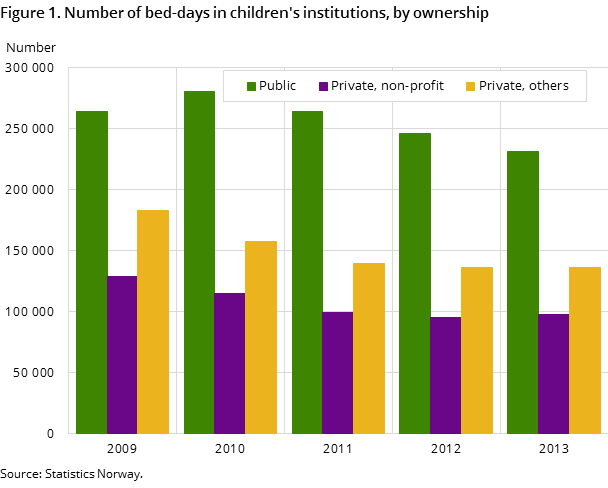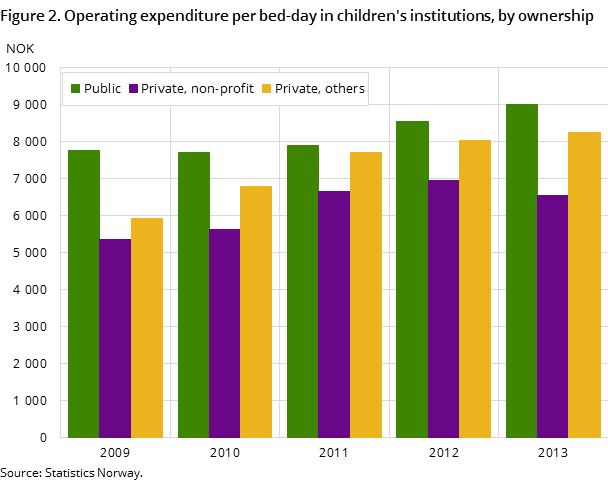Content
Published:
This is an archived release.
Fewer and fewer in institutions
The number of bed-days registered in children’s institutions in 2013 was 465 600. This is 12 000 fewer than in 2012, and the activity is continuing to decline. A total of 1 246 children were institutionalised at the end of 2013.
| Absolute figures | Per cent | ||
|---|---|---|---|
| 2013 | 2012 - 2013 | 2009 - 2013 | |
| 1Maternity homes are from the year 2010 included in the number of beds. | |||
| Number of beds1 | 1 745 | -0.8 | -6.6 |
| Number of children i childrens institutions | 1 246 | -2.6 | -19.4 |
| Treatment days (stays) during the year | 465 565 | -2.5 | -19.1 |
| Operating expenditures (NOK million) | 3 853.6 | -0.2 | 0.7 |
| Operating expenditures per treatment days | 8 277 | 2.3 | 24.5 |
| Publicly owned institutions | 9 021 | 5.5 | 6.3 |
| Owned by ideal private institutions | 6 552 | -5.9 | 22.1 |
| Owned by other private institutions | 8 255 | 2.6 | 39.1 |


The decline is mostly in publicly-owned institutions, with a 6 per cent drop. However, in institutions owned by Oslo municipality, which together with the state-owned institutions constitute the publicly-owned institutions, an increase in bed-days of almost 4 per cent was registered. Also in private non-profit institutions there was an increase of 3 per cent, while other private institutions had a decline of less than half a per cent.
Fewer bed-days in all regions
Some of the decline in state-owned institutions is due to a continued reduction in bed-days for unaccompanied juvenile asylum seekers in state-owned care centres.
There were fewer bed-days in all regions, and the decline was particularly significant in the West and South regions. In region South, the decline is partly explained by the transfer of Ringerike care centre to region East in 2013.
Care stays most common
Care stays , which also include unaccompanied juvenile asylum seekers, were the most common (38 per cent) type of stay. Voluntary stays accounted for 30 per cent and behavioural stays 19 per cent. Acute stays accounted for 13 per cent of total stays, which is an increase from 11 per cent in 2012.
A total of 1 246 children were institutionalised in 2013, compared with 1 279 in 2012. Fourteen per cent of all resident children were aged 12 years or younger, and more boys than girls were institutionalised (56 per cent boys).
Stays in non-profit institutions are least expensive
The institutions’ operating expenditure amounted to almost NOK 3.9 billion in 2013; about the same level as in 2009-2012. Operating expenditure per bed-day was NOK 8 300. Stays in publicly-owned institutions are about NOK 700 more expensive than this on average. The private non-profit operating expenditure per bed-day was NOK 6 500, while in other private institutions the corresponding figure was about NOK 8 250.
Fewer man-years in state-owned institutions
There was a decrease of more than 3 per cent in the number of contracted man-years adjusted for sick-leave and maternity leave in children’s institutions between 2012 and 2013. The decrease was in the state-owned institutions. However, there is some uncertainty related to these numbers due to changes in the organisation in 2012, which may cause reported errors to the data source for the statistics. It is certain that region West has reported errors to the data source for the statistics for both 2012 and 2013.
In the private institutions, the number of man-years increased in 2013, with almost 12 per cent more man-years in the other private institutions. In the non-profit private institutions and in institutions owned by Oslo municipality the number of man-years was stable.
Man-years region West Open and readClose
Region West had deficiencies in both 2012 and 2013 in the reporting of data for personnel in the institutions in the Employer and Employee Register, which is the source register for the statistics. Some personnel have wrongly been linked to the administration unit in the region. Administration is not included in these statistics and the level of man-years in institutions is too low for these two years.
Contact
-
Tone Dyrhaug
E-mail: tone.dyrhaug@ssb.no
tel.: (+47) 40 90 24 20
-
Unni Beate Grebstad
E-mail: unni.grebstad@ssb.no
tel.: (+47) 94 50 68 66
